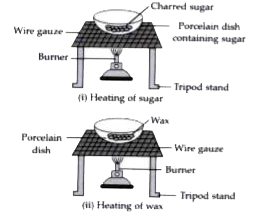Banana is a parthenocarpic fruit whereas oranges show polyembryony. How ar they different from each other with respect to seeds ?
Step-by-Step Solution:
1. Definition of Parthenocarpy:
- Parthenocarpy is a form of asexual reproduction in which fruits develop without fertilization, resulting in seedless fruits. In the case of bananas, they are classified as parthenocarpic fruits because they develop without the fusion of gametes, leading to the formation of fruit without seeds.
2. Characteristics of Banana:
- Bananas are seedless due to parthenocarpy. The ovary of the banana flower develops into a fruit without fertilization, meaning that no seeds are formed within the fruit. This makes bananas a popular choice for consumption as they do not contain seeds.
3. Definition of Polyembryony:
- Polyembryony is a phenomenon where multiple embryos develop from a single fertilized egg or from the same ovule. This occurs in some plants, including oranges, where several embryos can develop from a single seed.
4. Characteristics of Oranges:
- Oranges exhibit polyembryony, which means that when you cut open an orange seed, you may find multiple embryos inside. These embryos can arise from the zygote or from the surrounding tissue, leading to the formation of several embryos within a single seed.
5. Comparison of Seeds in Bananas and Oranges:
- The key difference between bananas and oranges with respect to seeds is that bananas do not have seeds at all (they are seedless due to parthenocarpy), while oranges contain multiple embryos within their seeds due to polyembryony. Therefore, bananas are seedless fruits, whereas oranges produce seeds that can contain several embryos.
Summary of Differences:
- Bananas:
- Type: Parthenocarpic fruit
- Seeds: Seedless (no seeds)
- Oranges:
- Type: Polyembryonic fruit
- Seeds: Contains multiple embryos (seeds present)
- Parthenocarpy is a form of asexual reproduction in which fruits develop without fertilization, resulting in seedless fruits. In the case of bananas, they are classified as parthenocarpic fruits because they develop without the fusion of gametes, leading to the formation of fruit without seeds.
- Bananas are seedless due to parthenocarpy. The ovary of the banana flower develops into a fruit without fertilization, meaning that no seeds are formed within the fruit. This makes bananas a popular choice for consumption as they do not contain seeds.
- Polyembryony is a phenomenon where multiple embryos develop from a single fertilized egg or from the same ovule. This occurs in some plants, including oranges, where several embryos can develop from a single seed.
- Oranges exhibit polyembryony, which means that when you cut open an orange seed, you may find multiple embryos inside. These embryos can arise from the zygote or from the surrounding tissue, leading to the formation of several embryos within a single seed.
- The key difference between bananas and oranges with respect to seeds is that bananas do not have seeds at all (they are seedless due to parthenocarpy), while oranges contain multiple embryos within their seeds due to polyembryony. Therefore, bananas are seedless fruits, whereas oranges produce seeds that can contain several embryos.
- Bananas:
- Type: Parthenocarpic fruit
- Seeds: Seedless (no seeds)
- Oranges:
- Type: Polyembryonic fruit
- Seeds: Contains multiple embryos (seeds present)
Topper's Solved these Questions
- SEXUAL REPRODUCTION IN FLOWERING PLANTSBOOK - PRADEEPCHAPTER - SEXUAL REPRODUCTION IN FLOWERING PLANTSEXERCISE - NCERT Exercise with Answers (Additional Questions (Long answer Questions ))
41 Videos
- SEXUAL REPRODUCTION IN FLOWERING PLANTSBOOK - PRADEEPCHAPTER - SEXUAL REPRODUCTION IN FLOWERING PLANTSEXERCISE - ANALYTICAL QUESTIONS WITH ANSWERS
18 Videos
- SEXUAL REPRODUCTION IN FLOWERING PLANTSBOOK - PRADEEPCHAPTER - SEXUAL REPRODUCTION IN FLOWERING PLANTSEXERCISE - NCERT Exercise with Answers (Additional Questions (Very short answer Questions ))
28 Videos
- REPRODUCTIVE HEALTHBOOK - PRADEEPCHAPTER - REPRODUCTIVE HEALTHEXERCISE - ASSERTION-REASON TYPE QUESTIONS
5 Videos
- STRATEGIES FOR ENHANCEMENT IN FOOD PRODUCTIONBOOK - PRADEEPCHAPTER - STRATEGIES FOR ENHANCEMENT IN FOOD PRODUCTIONEXERCISE - NOTABLE QUESTION
3 Videos
Similar Questions
Banana is a parthenocarpic fruit where oranges show polyembryony. How are they different from each other with respect to seeds?
View SolutionHow do Indian lakes differ from each other?
View SolutionCompare the two given changes. How are they different from each other?

View SolutionName the three isotopes of hydrogen. How do they differ from each other?
View SolutionHow many kinds of levers are there? How are they different from each other?
View SolutionHow do axon and dendron differ from each other?
View SolutionHow are sol, solution and suspension different from each other ?
View SolutionHow do euploidy and aneuploidy differ from each other?
View SolutionHow are sol, solution and suspension different from each other ?
View SolutionHow do pisces and tetrapods differ from each other?
View Solution
